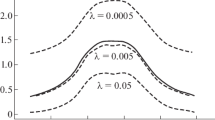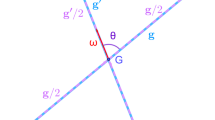Abstract
The restricted primitive model is an electrically neutral, classical model consisting of hard spheres charged either +q or −q. We show that, by appropriately selecting the diameter of the hard spheres, the pressure when q=0 can be made equal to that for a fluid of Maxwell–Boltzmann point ions and an ideal Fermi gas of electrons. We compare the series expansion of these classical and quantum systems and find that, except for intermediate de Broglie density and moderate to strong electrical interaction strength, the restricted primitive model gives a reasonable representation of the pressure of the corresponding quantum system. Much of the current interest, however, has been focused on the above, excepted region.
Similar content being viewed by others
REFERENCES
See, for example, H. L. Friedman, Ionic Solution Theory (Interscience Pubs., New York, 1962).
D. A. McQuarrie, Statistical Mechanics (Harper and Row, New York, 1976), Chap. 15.
G. Stell and J. L. Lebowitz, J. Chem. Phys. 49:3706 (1968).
G. Stell and K. C. Wu, J. Chem. Phys. 63:491 (1975).
B. Larsen, Chem. Phys. Lett. 27:47 (1976); J. M. Caillol, J. Chem. Phys. 100:2161 (1994); G. Orkoulas and A. Z. Panagiotopoulos, J. Chem. Phys. 101:1452 (1994); J. M. Caillol, D. Levesque, and J. J. Weis, Phys. Rev. Letts. 77:4039 (1996). 241 Pauli Principle and Restricted Primitive Model.6. See, for example, M. E. Fisher, and Y. Levin, Phys. Rev. Letts. 71:3826 (1993); Y. Levin, X.-j. Li, and M. E. Fisher, Phys. Rev. Letts. 73:2716 (1994); Phys. Rev. Letts. 74:3374 (1995); S.-N. Lai and M. E. Fisher, J. Chem. Phys. 103:8144 (1995); B. P. Lee and M. E. Fisher, Phys. Rev. Letts. 76:2906 (1996); Europhys. Lett. 39:661 (1997); Y. Levin and M. E. Fisher, Physica A 225:164 (1996); M. E. Fisher and B. P. Lee, Phys. Rev. Letts. 77:3561 (1996); D. M. Zuckerman, M. E. Fisher, and B. P. Lee, Phys. Rev. E 56:6569 (1997); S. Berkiranov and M. E. Fisher, Phys. Rev. Letts. 81:5836 (1998).
B. Hafskjold and G. Stell, in Studies in Statistical Mechanics, Vol. 8, J. L. Lebowitz and E. W. Montroll, eds. (North-Holland, Amsterdam, 1982), p. 175.
G. A. Baker, Jr., G. Gutiérrez, and M. de Llano, Ann. Phys. (NY) 153:283 (1984).
K. W. Kratky, Physica A 87:584 (1977).
F. H. Ree, Phys. Rev. 155:84 (1967).
G. D. Scott and D. M. Kilgour, J. Phys. D 2:863 (1969).
W. M. Visscher and M. Bolsterli, Nature 239:504 (1972).
See, for example, G. A. Baker, Jr., and P. R. Graves-Morris, PadéApproximants, 2nd ed., Encyclopedia of Mathematics and its Applications, Vol. 59, G.-C. Rota, ed. (Cambridge University Press, New York, 1996).
K. Huang, Statistical Mechanics (Wiley, New York, 1963).
G. A. Baker, Jr. and J. D. Johnson, Condensed Matter Theories, Vol. 2, V. C. Aguilera-Navarro, ed. (Plenum Press, New York, 1990), p. 1.
See, for example, S. Borofsky, Elementary Theory of Equations (Macmillan, New York, 1950).
G. A. Baker, Jr. and J. D. Johnson, Physica A 265:129 (1999).
P. Debye and E. Hückel, Z. Phys. 24:185 (1923).
See also, N. Bjerrum, Kgl. Dan. Vidensk. Selsk. Mat.-Fys. Medd. 7:1 (1926).
Author information
Authors and Affiliations
Rights and permissions
About this article
Cite this article
Baker, G.A., Johnson, J.D. The Pauli Principle and the Restricted Primitive Model. Journal of Statistical Physics 100, 233–242 (2000). https://doi.org/10.1023/A:1018647930248
Issue Date:
DOI: https://doi.org/10.1023/A:1018647930248




